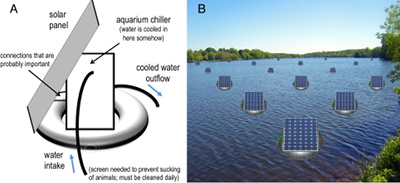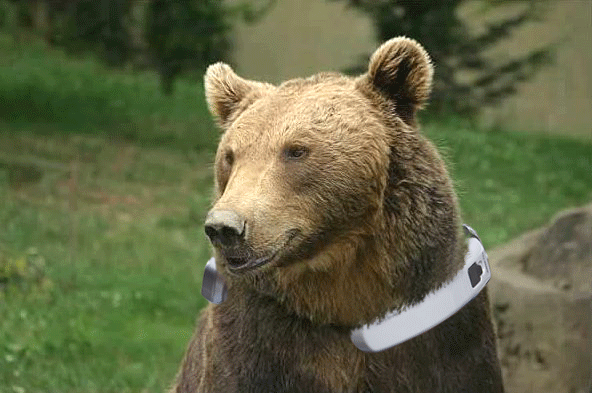
Tweet
October 2, 2014
Proceedings of the Natural Institute of Science | Volume 1 | SOFD 5
Assisted thermoregulation: a new conservation strategy for mitigating negative effects of global climate change
Charismatic Fauna Division1
1 - PNISsubmitted: September 12, 2014
accepted: September 20, 2014

Introduction
With global climate change poised to increase temperatures by as much as 4 degrees Fahrenheit within this century, the conservation of biodiversity must now focus on: 1) alleviating the negative effects of rising temperatures, and 2) providing support to affected species. One pioneering method to help species deal with climate change has been assisted migration (aka, assisted colonization or managed relocation); the process of moving species from one location to another that is predicted to contain optimal climatic conditions for that species (e.g., moving a species that prefers colder temperatures northward). Happily, many citizens have been so enthusiastic with this approach, that they have bypassed formal management plans and have taken it upon themselves to introduce relocate certain species to new geographic areas that those species have never experienced[1]. Clearly, these individuals are eager to mimc the success of other relocated species like zebra mussels, kudzu, and starlings.
Based on the success of numerous assisted migration programs (see Willis et al. 2010), we would like to propose another method for humans to help species cope with the negative effects of climate change: assisted thermoregulaton. Thermoregulation is the ability of most animals (and some plants) to regulate their own body temperatures (e.g., seeking shade on a hot, sunny day). One of the major concerns of increasing temperatures is that many species will just be unable to physiologically cope with the increased heat. For instance, all species have optimal ranges of body temperature (i.e., the body temperatures in which they perform the best). Temperatures above this range typically result in reduced performance, or possibly death. If humans can assist plants and animals in maintaining their optimal body temperatures in the face of a warming climate, then we might be able to help these species persist in a warmer world.
Here, we present three potential examples of how we can use assisted thermoregulation in action.
Example 1: Lizards in Deserts
Sinervo et al. (2010) recently cautioned that many species of lizards that inhabit Mexican deserts have a high risk of extinction from predicted climate change. When temperatures get too hot, lizards thermoregulate by entering cool, underground burrows. However, when a lizard is in a burrow, it is unable to forage for food. If temperatures continue to rise as predicted, the amount of time lizards spend in burrows will increase, and thus potentially lead to starvation. Higher temperatures are also known to negatively affect embryonic development of lizards.
Such negative effects of climate change on lizards can be easily mitigated using assisted thermoregulation. We observe that: 1) temperatures are cooler in the shade, and 2) deserts typically contain little aboveground shade. Cattle ranchers have long known that cows prefer shady areas (see Blackshaw and Blackshaw 1994; Tucker et al. 2008), and Kearney et al. (2009) found that shaded environments provide optimal ranges of temperatures for many cold-blooded species such as lizards.
Thus, we propose that shade-producing devices (i.e., beach umbrellas) should be installed in deserts in order to increase the amounts of aboveground shade. In Fig. 1 we demonstrate how umbrellas should be distributed across a landscape. Ideally, they should be spaced at distance that equals the maximum length of shade during the day, limiting the amount of shade-overlap and increasing the overall efficiency of umbrellas. We would advise against the use of bright colored umbrellas in order to prevent bees and other pollinators from confusing umbrellas with flowers. An appropriate color choice would be white, as it also has the highest albedo (i.e., reflects the most light).

Installing shade-producing devices across desert biomes would be a cost-effective method to help save lizards from extinction. Beach umbrellas can be purchased for as little as $20 per umbrella, or they can be built for about half the cost. In addition, this is a ‘multiple-species’ conservation approach as species other than lizards would benefit from the increased shade and lower temperatures.
Example 2: Aquatic Habitats
Assisted thermoregulation can also be applied to aquatic habitats. Rising air temperatures will cause a corresponding increase in water temperatures. The rate at which water temperatures are predicted to increase is expected to outpace the adaptive ability of many aquatic species. Thus, aquatic species will be subject to the same physiological dangers of increased temperatures (e.g., heat stroke, starvation, embryonic development, etc.) as terrestrial organisms.
We currently do not have the technology to force species to adapt quicker, but we can cool down water temperatures. Water chillers have long been used by aquarium-hobbyists to maintain cold water temperatures for certain fish species. Chillers take in water from the aquarium, cool it to a specified temperature, and then pump the cooled water back into the aquarium. Thus, we propose that chillers be installed around or within many types of wetlands (e.g., ponds, streams, lakes, and even oceans) to decrease future water temperatures. To offset energy costs of the chillers, solar panels or wind turbines could be used as a power source (see Fig. 2A).

One drawback of this method could be the cost. A 1 horsepower chiller can decrease the temperature of a 1,000 gallon aquarium by about 1 degree Fahrenheit. So, a small lake, like Walden Pond, that contains about 500,000,000 gallons of water would require 500,000 1-HP chillers to reduce the temperature of the lake by 1 degree Fahrenheit. At a cost of $1,000 per chiller, this comes to about a $5 million contribution from the Walden Estate for the chillers alone. In addition, the lake may suffer reduced income from recreational use because the numerous chiller units floating on the lake (for a 240 acre lake, there would be one unit every 20 feet, see Fig. 2B) would greatly reduce the ability to fish, jet-ski, or enjoy the lake’s aesthetics. Although, the added benefit to the aquatic community from decreased recreational use should not be overlooked.
Example 3: Species with Large Ranges
The first two examples represent localized mitigation techniques. However, many species, such as large mammals and migratory birds, traverse vast distances across many different types of habitats. How may assisted thermoregulation help these types of species?
In these cases, assisted thermoregulation would be the most cost-effective if it were to focus on the individual rather than on specific habitats (i.e., instead of cooling down an entire habitat, we should cool down an entire individual). Currently, the only method available for cooling at the individual-scale is the CoolWare Personal Cooling System (available here).
Thus, we propose that large animals that travel great distances should be outfitted with these Personal Cooling Systems (PCSs; Fig. 3). These PCSs could be easily affixed when the animal is sedated, as happens when an animal is being fitted with a radio collar. In fact, PCSs could be integrated with radio collars to minimize cost and disturbance to the animal. PCSs for birds would have to be light enough to allow the individual to fly.

One small drawback of PCSs is that they need to be refilled with water every 4 hours, so animals would have to be recaptured at least twice a day (or more frequently in summer months). PCSs are also fairly expensive, so units would have to be re-used and attached to only the most fit individuals (e.g., individuals that are not suffering from disease or that are not likely to become victims to a predator attack). Despite these limitations, we believe that PCSs will become a valuable conservation tool in this upcoming century.
Conclusions
Climate change is an environmental disturbance the likes of which have never been experienced by any of the species currently inhabiting the Earth. Thus, conservation of these species requires the use of methods that also have never before been experienced. Like assisted migration, assisted thermoregulation represents a way for us to intervene and help species cope with rising temperatures. We highly encourage everyone to immediately take action to help species thermoregulate.
References
Blackshaw JK and Blackshaw AW. 1994. Heat stress in cattle and the effect of shade on production and behaviour: a review. Australian Journal of Experimental Agriculture 34:285-295.
Kearney M et al. 2009. The potential for behavioral thermoregulation to buffer “cold-blooded” animals against climate warming. PNAS 106:3835-3840.
Sinervo B et al. 2010. Erosion of lizard diversity by climate change and altered thermal niches. Science 328:894-899.
Tucker CB et al. 2008. Effect of solar radiation on dairy cattle behaviour, use of shade and body temperature in a pasture-based system. Applied Animal Behaviour Science 109:141-154.
Willis SG et al. 2009. Assisted colonization in a changing climate: a test-study using two U.K. butterflies. Cons. Letters 2:46-52.
Footnotes
[1] The best example being the Torryea Guardians, a group of citizens that have already planted Torryea pines in areas that are outside of their native distribution. [Return to main text]

Proceedings of the Natural Institute of Science (PNIS) by https://instsci.org/ is licensed under a Creative Commons Attribution-ShareAlike 4.0 International License.